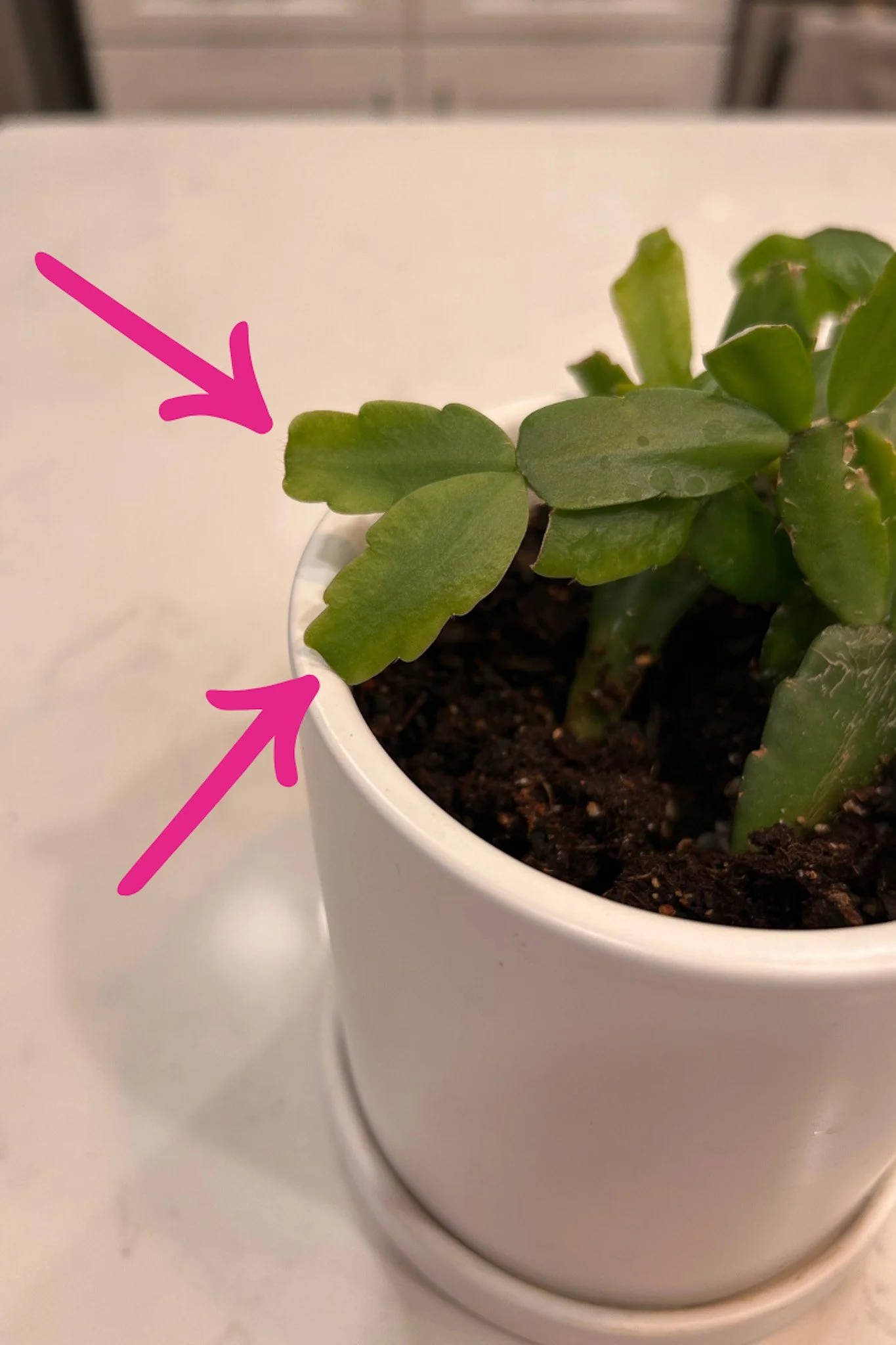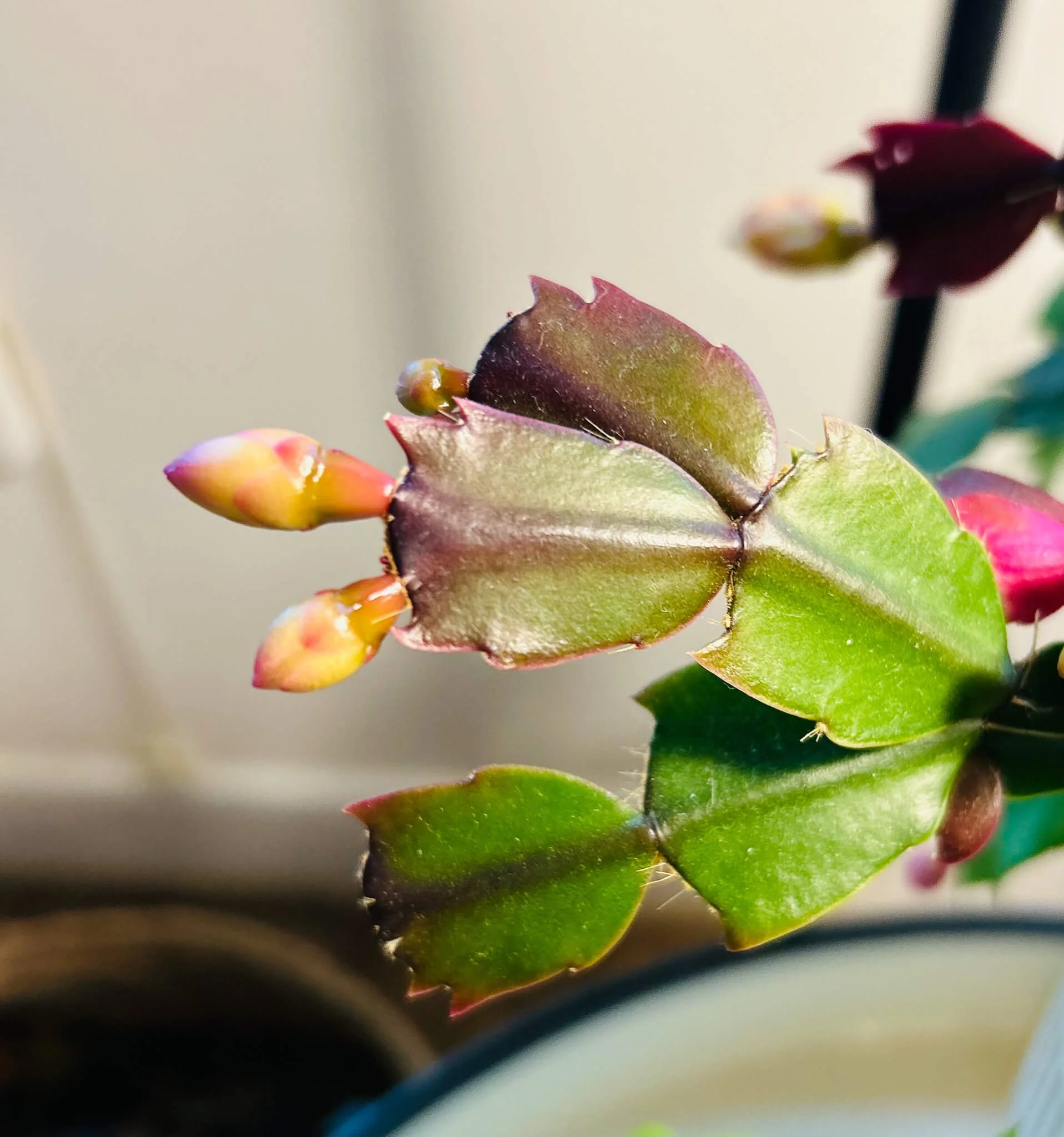Thanksgiving Cactus Plant
Are Thanksgiving Cactus and Christmas Cactus the Same?
Learn About Thanksgiving Cactus Identification, and How to Take Care of This Soft and Fleshy Tropical Cactus
The Thanksgiving cactus, also known by the latin name Shlumbergera truncata, is a type of cactus native to the cool, moist and humid rainforests of Brazil, where it clings to rocks and tree branches instead of growing in the ground.
Despite belonging to the same scientific family called Cactaceae, the Thanksgiving cactus is not the stereotypical prickly, spiny, heat-loving plant that most people associate with cactus plants.
Instead, the Thanksgiving cactus plant has soft, fleshy, flattened leaf-like stems and tubular, 1-3 inch flowers that come in shades of pink, red, white, orange, and golden yellow.
Plants typically bloom from November to January, and may occasionally rebloom again in the spring.
Thanksgiving Cactus Identification
The Thanksgiving cactus plant in full bloom.
Identifying a Thanksgiving cactus plant can be tricky, as it’s often confused with the Christmas cactus and Easter cactus, but it has distinct features that set it apart.
The most notable characteristic is its segmented stems, called cladodes, which have sharp, pointed edges resembling tiny claws—unlike the rounded or scalloped segments of its cousins.
Thanksgiving cacti also tend to bloom earlier in the season, showcasing flowers in hues of pink, red, white, orange, and golden yellow.
Another clue is its upright growth habit, which can give it a more structured appearance compared to the drooping stems of the Christmas cactus.
Scroll down for Thanksgiving cactus vs Christmas cactus pictures, as well as Thanksgiving cactus vs Easter cactus pictures.
Thanksgiving Cactus vs Christmas Cactus
Are Thanksgiving cactus and Christmas cactus the same? Many people confuse Christmas cacti and Thanksgiving cacti, since they have similar appearances and care requirements. However, there are a few key differences between the two that are fairly easy to spot:
Stem segments: The Thanksgiving cactus plant (Schlumbergera truncata) features stem segments with pointed, claw-like edges, giving it a sharper appearance, while the Christmas cactus (Schlumbergera bridgesii) has rounded and scalloped edges on the ends of its stem segments.
Bloom time: The Thanksgiving cactus typically blooms in late November, aligning with its namesake holiday, while the Christmas cactus starts flowering in late December.
Flower form: Both plants produce similar flowers with subtle differences. Thanksgiving cactus flowers have a more upright appearance, whereas Christmas cactus blooms are pendulous and delicately dangle from the plant.
Thanksgiving Cactus vs Christmas Cactus Pictures
The Thanksgiving cactus has pointy tips on each stem segment.
The Christmas cactus has round, scalloped edges on each stem segment.
Thanksgiving Cactus vs Easter Cactus
Are Thanksgiving cactus and Easter cactus the same?
Stem segments: The Thanksgiving cactus has segmented stems with pointed, claw-like edges, giving it a sharper and more angular appearance than its Easter cactus cousin Rhipsalidopsis gaertneri . The Easter cactus plant has rounded segments with smooth edges that feel softer to the touch.
Flower form: The flowers of each type of plant are distinct and easy to tell apart due to their unique shapes. Thanksgiving cactus flowers are tubular and symmetrical, while Easter cactus flowers are star-shaped with thinner, more delicate petals that create a layered effect.
Flowering time: Another notable difference when comparing Thanksgiving cactus vs Easter cactus is the flowering time. The Thanksgiving cactus plant starts to bloom in late November while the Easter cactus flowers in March and April.
Thanksgiving Cactus vs Easter Cactus Pictures
The Easter cactus has rounded segments with smooth edges that feel soft to the touch.
The distinctly pointed tips of a Thanksgiving cactus.
This article contains affiliate links, which means I may earn a small commission at no extra cost to you. These commissions help me to continue bringing you free, high-quality design articles. Thank you for your support!
Thanksgiving Cactus Care
A Thanksgiving cactus is very easy to care for and does well as an indoor houseplant.
It prefers bright, indirect light - make sure to avoid direct sun, or the stems will “sunburn” and turn purple.
Water every 1-2 weeks, when the top inch of soil feels dry. Do not let the soil dry out completely, and make sure the pot has drainage holes.
Pruning isn’t necessary unless you would like a bushier plant. Prune in late winter, when flowering has finished, by pinching off the stem segments with your fingers, or cut them off using sharp, clean scissors.
The Thanksgiving cactus plant prefers to be root-bound. Being root-bound means that a plant's roots have grown so densely within its pot that they have limited space to expand.
This often results in the roots circling around the pot or becoming tightly packed.
The Thanksgiving cactus tends to bloom more heavily when it's root-bound because the restricted root space signals the plant to focus on reproduction rather than growth.
This stress encourages the cactus to produce more flowers, which are essentially its means of propagating seeds.
When caring for a Thanksgiving cactus, avoid frequent repotting. Instead, repot it only every 3–5 years or when absolutely necessary, such as when the plant has outgrown its pot or the soil has degraded. This balance ensures the plant stays healthy while still encouraging abundant blooming.
When cared for correctly, Thanksgiving cacti can be extremely long-lived plants, often living up to 100 years and getting passed down through family generations!
What is the Best Soil for Thanksgiving Cactus?
In their native habitats, Thanksgiving cacti are ephipytes, found growing on trees or rocks rather than directly in soil.
Epiphytic plants harmlessly grow on other plants or surfaces and rely on air, rain, and debris for nutrients.
To mimic these conditions in cultivation, it’s crucial to provide a well-draining and free-flowing potting mix.
A blend with approximately 80% cactus potting soil and 20% perlite works well, ensuring proper aeration for the roots.
Always use a pot with drainage holes to prevent waterlogging, which can lead to root rot.
For added care, allow the soil to dry out slightly between waterings, as these cacti prefer conditions similar to their epiphytic origins.
Proper soil and drainage are key to keeping your plant healthy and thriving!
Thanksgiving Cactus Fertilizer
During spring and summer, it’s important to support the growth of your Thanksgiving cactus plant with regular fertilization.
Use an all-purpose, water-soluble indoor plant fertilizer, such as Jack’s Classic All Purpose 20-20-20, which provides a balanced mix of essential nutrients (that’s not a sponsored endorsement, it’s simply a product I personally use and find to be very dependable).
Apply the fertilizer once a month by diluting it according to the package instructions and watering the plant with the solution.
This helps promote healthy foliage, strong root development, and vibrant blooms.
Regular feeding during the active growing season ensures your plant has everything it needs to thrive and maintain its lush appearance.
How To Make Thanksgiving Cactus Bloom
The Thanksgiving cactus is a reliable bloomer, rewarding you with gorgeous flowers year after year. Many people find that their Thanksgiving cactus reblooms without any special effort.
Whether or not your cactus flowers every year depends largely on the conditions in your home, including temperature, lighting, and its proximity to a window.
Some lucky folks simply keep their cactus in the right spot without realizing it, and voilà—blooms appear. But if your plant seems stubborn, don’t worry—there are tried-and-true methods to help coax those buds into action.
If you want to guarantee blooms, a little intervention might be in order (though some techniques sound more like elaborate pranks on your poor cactus!).
The key is giving your plant 6–8 weeks of cooler temperatures, ideally between 55–65°F, combined with 14 hours or more of continuous darkness each day.
To create this environment, you could move your Thanksgiving cactus plant to a cool, dark closet or garage, or go the DIY route by placing a box over it every evening—yes, it might feel a little ridiculous, but it works!
After this “neglectful" treatment, buds should start to form, and you can bring the plant back to its usual sunny spot just in time to show off its blooms for Thanksgiving.
To make your Thanksgiving cactus bloom, move it into a cool, dark closet or garage for 14 hours or more per day.
Where Can I Buy a Thanksgiving Cactus?
Each year, starting in late October to early November, the Thanksgiving cactus plant is readily available in plant shops, local nurseries, grocery stores, and big box centers.
Plants are frequently shipped to stores either heavily budded and ready to bloom, or already in bloom.
The Thanksgiving cactus is frequently labeled incorrectly and sold as a Christmas cactus. However, a true Christmas cactus is not as commonly available to purchase in most retail settings due to having fragile, breakable foliage.
You can buy a true Christmas cactus from some garden centers, online nurseries, online marketplaces like Etsy, or plant shops that specialize in succulents and cacti.
Are Thanksgiving Cactus Poisonous to Cats or Dogs?
If you have recently been gifted a Thanksgiving cactus or bought one on impulse, you may be wondering if the Thanksgiving cactus is toxic to cats or dogs, and if it’s safe to have around your furry companions.
The great news is that the Thanksgiving cactus plant is non-toxic and is not poisonous to cats or dogs. So if you are plant obsessed (like me) you can go ahead and get one in every color 😜 I currently have 6 Thanksgiving cactus plants and 4 rescue pets. Don’t judge.
Unlike some other types of cacti that have spines or potentially irritating or toxic sap, Thanksgiving cacti are safe for pets!
However, it's always a good idea to monitor your pets around plants and consult with a veterinarian if you have specific concerns or if your pet shows any signs of illness after contact with the plant.
To learn more about plants poisonous to dogs and cats, read “Which Plants are Toxic to Dogs?” and “Does your Cat Eat your Houseplants?”, or visit the ASPCA’s list of toxic and non-toxic plants.
Are Thanksgiving cactus poisonous to cats? Tom, our chief plant taster, reminds us that it’s okay for cats to have an occasional nibble.
Thanksgiving Cactus Problems
One of the most frequent problems I see with Thanksgiving cacti is that they often come in decorative foil wrappers, which many people leave on. While these wrappers may look festive, they prevent the plant from getting the proper drainage it needs.
When the foil wrapper is left on, water cannot drain away properly and it accumulates in the pot, leading to root rot, wilting, and yellowing leaves. To avoid these issues, it’s crucial to remove the foil wrapper immediately!
You can either place the plastic pot on a saucer to catch excess water, or if you want a more polished look, repot the cactus immediately into a decorative pot with drainage holes that sits on a saucer to protect your furniture.
Why Is My Thanksgiving Cactus Turning Purple or Red?
Bright, direct light - too much direct sunlight can cause the leaves of the Thanksgiving cactus to produce an overabundance of the purple pigment anthocyanin. Thanksgiving cacti generally prefer bright, indirect sunlight. Try moving your plant to a location out of harsh, direct sun.
Nutrient deficiency - a lack of essential nutrients, particularly phosphorus, can result in changes in leaf color. Consider fertilizing your Thanksgiving cactus with a balanced, water-soluble fertilizer designed for houseplants during the growing season.
Temperature - Thanksgiving cacti tend to appreciate cooler temperatures during their resting period. Exposure to excessively high temperatures from direct sun or heating vents can sometimes lead to discoloration. Try moving your cactus to a spot away from these triggering situations.
Improper watering - Overwatering or underwatering can stress the plant and lead to changes in leaf color. Water every 1-2 weeks, when the top inch of soil feels dry. Do not let the soil dry out completely. Good drainage is a must - make sure the pot or planter has drainage holes so water can drain freely out the bottom, and use a potting mix that is loose and well-draining. For a good ratio, mix 80% potting soil with 20% perlite.
The leaves of this Thanksgiving cactus are turning purple. Time to assess the plant’s location, watering and fertilizing schedule!
Why Is My Thanksgiving Cactus Wilting and Drooping?
Overwatering: Excess water can lead to root rot, causing the plant to wilt. Ensure the soil dries out slightly between waterings.
Underwatering: Prolonged dry soil can dehydrate the plant, making it limp. Take your plant to the sink and give it a thorough watering until water flows out from the drainage holes. Water your plant more freqently.
Poor drainage: A pot without proper drainage can cause waterlogged roots. Repot your plant into a pot with drainage holes.
Incorrect soil mix: Dense, poorly draining soil can suffocate the roots. Use a well-draining cactus mix.
Nutrient deficiency: Lack of essential nutrients may result in poor plant health and drooping stems.
Root-bound conditions: If the plant is too root-bound, it may struggle to absorb water and nutrients effectively. Repot your Thanksgiving cactus plant every 3-5 years.
Insufficient light: Although they prefer indirect light, too much shade can weaken the plant over time.
Why Is My Thanksgiving Cactus Dropping Buds?
Temperature fluctuations: Sudden changes in temperature, especially cold drafts or blasts of heat from a vent, will cause the plant to drop its buds.
Inconsistent watering: Both overwatering and underwatering can stress the plant and lead to bud drop.
Insufficient light: Not getting enough light, especially during the bud-forming stage, will cause a Thanksgiving cactus plant to drop its buds.
Stress from being moved: Changes in location or environment will cause bud dropping.
Natural blooming cycle: Plants may naturally shed buds, especially if they are near the end of their blooming cycle.
Why Is My Thanksgiving Cactus Turning Yellow?
Overwatering: Too much water can cause root rot, leading to yellowing leaves. Give the soil a chance to dry out between waterings.
Underwatering: Not watering enough can stress the plant and cause it to yellow. Adjust your watering schedule and increase the frequency of waterings.
Poor drainage: If the pot doesn't have proper drainage, water can accumulate, leading to yellowing. Repot your plant in a container with drainage holes.
Nutrient deficiency: A lack of essential nutrients, especially nitrogen, can cause yellowing. Fertilize your plant according to the schedule outlined above.











